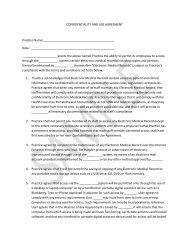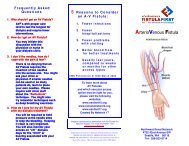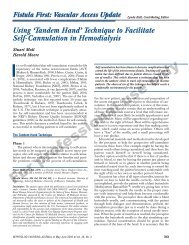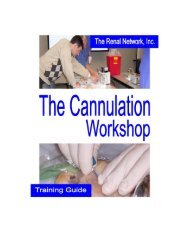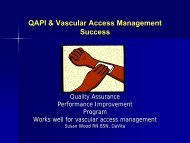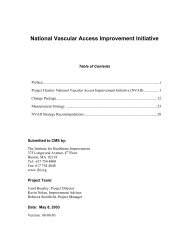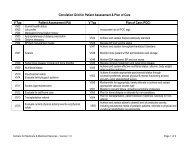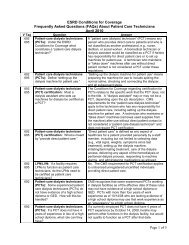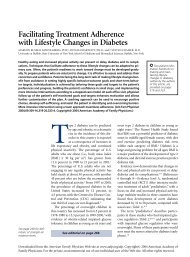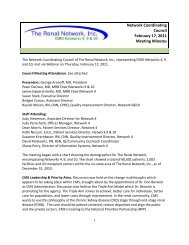Master Cannulator Program - The Renal Network
Master Cannulator Program - The Renal Network
Master Cannulator Program - The Renal Network
Create successful ePaper yourself
Turn your PDF publications into a flip-book with our unique Google optimized e-Paper software.
Cannulation Team<br />
DSI Marion County<br />
Pat Coryell, RN, CNN
Set-up<br />
14 physicians (NIM)<br />
4 “sister” clinics (DSI)<br />
6 “step sister” clinics (FMC)<br />
3 nurse practitioners<br />
2 surgeon groups<br />
2 hospitals<br />
Patient count 110-120
FF-Our Story<br />
11 Change Concepts<br />
July 2007<br />
#1 “Routine CQI Vascular Access”<br />
CQI Team: Access Coordinator, Facility<br />
Manager, Medical Director, Nurse<br />
Practitioners<br />
103 patients<br />
CATHETERS! 32%<br />
24 permanent, disease or refusal
2728 Review<br />
Front page of 2728:<br />
18 b. Was patient under the care of a<br />
nephrologist?<br />
Yes/No/Unknown 6-12 mo. >12 mo.<br />
18 d. What access was used for first<br />
out patient dialysis?<br />
AVF Graft Catheter
Data<br />
Current patients in that month onlyadmitted<br />
after 1-1-2006 (new 2728)<br />
February 2008-56% of 51 patients were seen prior<br />
to initiation of dialysis.<br />
25% of 51 patients (13) were seen> 6 months prior<br />
to initiation of dialysis and started dialysis with a<br />
catheter<br />
11 physicians received a data table re: their patient<br />
admits
Data<br />
July 2008-30.6% of 62 current patients were seen<br />
prior to beginning dialysis.<br />
19 (all) were seen> 6 months prior to initiation of<br />
dialysis and all started dialysis with a catheter<br />
14 physician received a data table re: their patient<br />
admits, requested PCP outreach<br />
#2“Timely Referral to a Nephrologist”<br />
Discussed with Medical Director in CQI about the<br />
physician group to doing a PCP outreach about<br />
early referral and evaluation
Data<br />
May 2009-39.3% of 61 current patients<br />
were seen >6 months prior to initiation of<br />
dialysis<br />
29.5% (18) started with a catheter<br />
Data table sent to physician group director<br />
and Facility Medical Director with a<br />
request for PCP outreach project for early<br />
referral and evaluation<br />
**24 permanent catheters
Surgeon Issues<br />
Few successful “1 st ” placements of AVFs<br />
“Can’t, or won’t” place AVF, only AVG $$$<br />
Vein Mapping in office only, will not accept from<br />
hospital<br />
Inexperienced surgeons<br />
Not allowed to refer to “outside” surgeon<br />
groups (politics), hospital privileges<br />
#4 “Surgeon selection based on best outcomes”<br />
#5 “Full range of surgical approaches to evaluation<br />
and placement”<br />
#6 “Secondary AVF placement”
Oct. 2007, Letter sent to surgeons showing their<br />
current data and detailing the FF Initiative. We ask<br />
for cooperation.<br />
Surgeon1 Surgeon2 Surgeon3 Surgeon4<br />
Graft 18 1 6 1<br />
Fistula 19 2 1 10
Dec 2007, Letter sent to surgeons, included<br />
data, and requested AVF FIRST unless<br />
discussed alternative with nephrologist.<br />
Surgeon<br />
1<br />
Surgeon<br />
2<br />
Surgeon<br />
3<br />
Surgeon<br />
4<br />
Graft 17 1 2 3<br />
Fistula 22 1 1 9
Fall 2008<br />
It was decided, in CQI, that all<br />
access referrals would go to one<br />
surgeon unless insurance did not<br />
permit
April 2009, We have added one new<br />
surgeon to group who states he is FF.<br />
3 AVFs transferred in.<br />
Surgeon<br />
1<br />
Surgeon<br />
1.5<br />
Surgeon<br />
2<br />
Surgeon<br />
3<br />
Surgeon<br />
4<br />
Graft 13 1 1 4 2<br />
Fistula 20 4 3 7
“NIMAT”<br />
at Indiana Kidney Institute (IKI)<br />
May 2008: invited a collective of facility<br />
managers and access coordinators from all sister<br />
clinics:<br />
IKI-neutral ground-only 3 other facilities<br />
represented (Access Coordinator for all NIM<br />
facilities)<br />
Presented 2728 data<br />
Presented surgeon data<br />
Ask group (shared NIM physicians) to participate in<br />
FF data collection hoping to encourage continuity<br />
of care for all NIM patients and encourage<br />
physicians<br />
#11 “Outcomes feedback to guide practice”<br />
(2nd meeting-flop)
Access Flows-July 2007<br />
IKI Coordinator<br />
Monthly Access Flow studies reviewed by Access<br />
Coordinator for NIM group<br />
Contact with each facility/access coordinator<br />
Reviews access flow results monthly<br />
Requests repeat access flows or fistulagrams<br />
Calls for assessments<br />
Sends reports<br />
Reviews access history<br />
Feb 2009, In-service training for staff to<br />
learn what and why to report<br />
#9 Monitoring and maintenance to ensure<br />
adequate function”
July 2007<br />
Patient Education (again and again!)<br />
Tools<br />
Websites: FF, TRN, INC.,<br />
ESRD <strong>Network</strong>s<br />
Posters, hand-outs, discussion, DSI<br />
education, Access Choices bi-annual<br />
thru DSI<br />
#10 “Education for Caregivers and<br />
patients”
Caregiver Education (#10)<br />
April 2008<br />
Cannulation Workshop<br />
“CHICKEN LAB”<br />
Access anatomy/physiology<br />
Auscultation/Palpation<br />
Catheter complications<br />
AVF/AVG surgical repairs<br />
Staff “one on one” teaching prn<br />
#8 “Cannulation training for AV fistulas” (last one)
Are we getting anywhere?<br />
FRUSTRATION!!!<br />
Patient refusals<br />
Physician resistance<br />
Surgeon resistance<br />
Staff resistance<br />
“What difference can WE really make to our<br />
patients now?<br />
Preserve their accesses!
Why Begin a Cannulation Team?<br />
We Can Make an Impact<br />
Preserve the established accesses of<br />
our patients<br />
Preserve the new accesses of our<br />
patients<br />
Anticipate access problems, and<br />
correct them, before the access fails<br />
TO PREVENT ACCESS FAILURE
How to Begin<br />
Recognize there is a problem<br />
1. Are there many infiltrations and misses?<br />
2. Have you had to set a limit on<br />
cannulation attempts?<br />
3. Are certain staff always requested to<br />
cannulate?<br />
4. Do you hear “no-one can stick it?” yet<br />
one or two staff always can.<br />
5. Send patients for fistulagram and the<br />
results are “no occlusion or narrowing”
Staff Training<br />
Orientation-many experienced PCTs<br />
Cannulation Camp, Chicken Lab<br />
IKI: presented an in-service on<br />
anatomy/physiology of access:
Set a Goal<br />
Minimize the amount of cannulation<br />
attempts per access, preserve new<br />
accesses<br />
1. Rule: Any patient’s access<br />
cannulated 2 times by a single staff,<br />
without success, must then be<br />
referred to the nurse, who will<br />
cannulate, appoint another<br />
cannulator or refer to IR/surgeon
Did it Work?<br />
Staff went to other staff to ask for<br />
help rather than to the nurse<br />
Staff chose who to ask to recannulate<br />
the patient<br />
1. “I know I can do this”<br />
2. “<strong>The</strong> nurse was busy”<br />
3. “So and so stuck her last time”<br />
4. “She wanted so and so to stick<br />
her”
Result: Still<br />
1. Many infiltrations and misses.<br />
2. Certain staff were always requested to<br />
cannulate and lost their patient care time.<br />
3. I still heard “no-one can stick it?” yet one<br />
or two staff always did.<br />
4. Accesses were frequently “rested”, PCs<br />
were left in longer.<br />
5. AVFs and AVGs were referred back to<br />
surgeons/for fistulagrams, just for us to<br />
hear “there is nothing wrong”
Make a Plan<br />
Let’s develop a <strong>Master</strong><br />
<strong>Cannulator</strong> <strong>Program</strong>!
Process/Compare Results<br />
<br />
DATA-comparison:<br />
#10 new AVFs and #5 new grafts<br />
since 1-2008<br />
#6 prior to 12-08 averaged 9 weeks<br />
to consistent cannulation<br />
(2 needles 6 dialysis in a row)
Evaluation<br />
Second Step: Evaluate staff<br />
cannulation techniques and<br />
knowledge<br />
1. Placed the nurses in charge of<br />
evaluating staff
Cannulation Skill Tool<br />
<br />
<br />
<br />
<br />
<br />
<br />
<br />
<br />
<br />
<br />
<br />
<br />
<br />
<br />
Cannulation Skills Check-Off<br />
Name:__________________________<br />
Date:___________________________<br />
Nurse Instructor:__________________<br />
Defines access by anatomy/physiology<br />
Assesses access by palpation and auscultation<br />
Identifies direction of blood flow<br />
Chooses needle site with care to needle length and needle gauge<br />
Inserts needle at proper angle, without trauma<br />
Places needles within vessel with care to vessel path<br />
Using syringe, checks for adequate blood flow<br />
Proper taping to secure access needle<br />
Identifies aneurysm/pseudo aneurysm<br />
Identifies symptoms of infection/reduced blood- flow/clotting<br />
FISTULA GRAFT
Result: staff resistance<br />
All staff passed with flying colors<br />
(hmmmmmmm?????)<br />
Continued infiltrations and multiple<br />
needle sticks<br />
Ego issues<br />
Some staff who had requested help<br />
before with cannulations were not<br />
asking for help now
Plan #2<br />
<br />
Appoint one person to evaluate<br />
staff for consistency<br />
1. Participates regularly in patient care<br />
2. One on one, pull up a chair!<br />
3. Discussion/demonstration of skills<br />
4. Staff Education opportunity
Assigned “<strong>Master</strong> <strong>Cannulator</strong>”<br />
Staff assigned to cannulate<br />
new and troubled accesses:<br />
One exception<br />
1. If assigned staff member was busy<br />
then the person assigned to the pt<br />
would:<br />
Go to “their” chosen staff for help<br />
Stick the patient themselves (too<br />
many times)
Consequently<br />
<strong>The</strong> idea for the Cannulation Team<br />
was born.<br />
How to choose:<br />
1. <strong>The</strong> most requested “stickers” were also<br />
the most skilled:<br />
Instincts<br />
Touch<br />
Planned needle placement<br />
Listened to the patient
<strong>The</strong> Team<br />
<strong>The</strong> Nurse Captain (good sticker, works<br />
both shifts)<br />
1. Nurse Captain makes all cannulation<br />
assignments (new and difficult)<br />
2. Reviews access problems with pt, team,<br />
IKI, NPs, and Access Coordinator<br />
3. Nurse Captain appointed 3 day-shift PCTs<br />
and one evening-shift PCT (rotate) who<br />
now receive staff support (mostly)<br />
3. Monitors care and c/o for all AV accesses<br />
4. Starts “Access Initiation Tool”
Corrective Action<br />
Still some resistance: Non assigned<br />
staff receive reprimands for not<br />
allowing team member who is<br />
assigned to cannulate their patient.<br />
May require re-orientation, no matter<br />
what their experience level is
Result of Rotating Needles
Access Initiation Tool<br />
<br />
DSI Guidelines for Cannulating a NEW AVF<br />
DIRECTIONS:<br />
<strong>The</strong> Readiness of the AVF (arterio-venous fistula) is determined by the access surgeon, the nurse<br />
practitioner, and the RN assessment. <strong>The</strong> goal is to gently use the AVF when new to promote<br />
maturity and strength allowing the AVF to progress to the prescribed BFR (blood flow rate). This<br />
protocol may be adjusted by the RN, based on access assessment. However, the progression<br />
should be maintained.<br />
ONLY ASSIGNED STAFF SHOULD CANNU8LATE THE NEW AVF DURING THE PROTOCOL<br />
PERIOD:<br />
Always use a tourniquet for the AVF.<br />
Use only 17 gauge needles unless otherwise specified by the access surgeon.<br />
Indicate success by checking yes or no. Comment on any problems.<br />
If a vascular access event occurs (infiltration, low arterial flows) report to RN. DO NOT attempt<br />
another needle stick. <strong>The</strong> RN will report to the nephrologist for follow-up referral.<br />
If an infiltration occurs, use the catheter for one more week before attempting to use the AVF<br />
again.<br />
TX #ARTERIALVENOUSBFRTX DATECommentsInitials117 ga17 ga200217 ga17 ga200 X 10 min,<br />
then 250317 ga17 ga200 X 10 min then 250<br />
Start DateARTERIALVENOUSBFRTX #1TX #2TX #3COMMENTSINI.1st Week17 ga17 ga200 X 10<br />
min then 250SuccessY NSuccessY NSuccessY N2nd Week16 ga16 ga250 X 3 TXSuccessY<br />
NSuccessY NSuccessY N3rd Week16 ga16 ga300 X 3 TXSuccessY NSuccessY NSuccessY<br />
N4th Week16 ga16 gaOrdered BFRSuccessY NSuccessY NSuccessY N<br />
Projected start date to begin using 15 ga needles: _____________________________<br />
Name:_________________Initials:____ Name:_________________Initials:____<br />
Name:_________________Initials:____ Name:_________________Initials:____<br />
Name:_________________Initials:____ Name:_________________Initials:____<br />
<br />
File form under “Access Information Sheet” in PEARL.
Evidence of Success<br />
1. Happier patients, less c/o, less<br />
requests for certain “stickers”<br />
2. Healthier AVFs<br />
3. Earlier referral for problems<br />
(immaturity/placement/size)<br />
4. Buttonholes (even helped a sister<br />
clinic develop a buttonhole)
DATA<br />
#4 new accesses (AVFs) since 12-08<br />
#3 3 weeks to success with the TEAM<br />
#1 waiting to heal from transposition
Future<br />
a tracking record has been added to<br />
our computer system (Feb 09)<br />
“adverse events” to track infiltrations<br />
and >2 needle placements<br />
Buttonhole policy requires “one on<br />
one” scheduling for 3 weeks ( we<br />
have one success, 100%, so far)<br />
Visibly there are less access<br />
problems, less patient complaints
Re-evaluation of Team<br />
On-going process<br />
Add new members as new staff<br />
arrives and proves themselves<br />
Non team members included in<br />
evaluation process:<br />
1. Access conditions<br />
2. Access Flow evaluations (provided<br />
Access Flow interpretation training)<br />
3. Pre and Post dialysis access care
Visible Outcomes<br />
Improved patient confidence<br />
Improved staff knowledge<br />
Improved staff team-work<br />
Saving accesses
Have We Improved?<br />
Mar 08-Mar 09 AVF up 7<br />
percentage points<br />
Don’t Quit!!!



